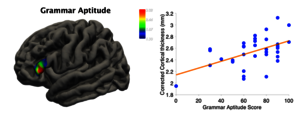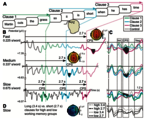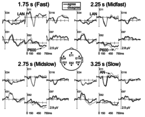Grammar
A thicker Broca's area is better for grammar learning

In a spatially unbiased whole-brain analysis, we found correlation between cortical thickness in the frontal part of Broca's area and aptitude for grammar learning in adults (Novén, Schremm, Nilsson, Horne, & Roll, 2019). Specifically, participants with thicker cortex in this area scored higher on the LLAMA F (Meara, 2005) artificial grammar learning test. In the homologue area in the right hemisphere, participants with thinner cortex were better at pitch discrimination, in line with previous results (Hyde et al., 2007). It might be the case that a thinner, more streamlined cortex is better for tasks involving lower complexity, whereas high-complexity tasks benefit from a thicker cortex with increased possibilities of neural connections (Novén, Schremm, Nilsson, Horne, & Roll, 2019).
Time constraints on working memory and language processing


The form of words and sentences starts fading away in short-term memory after only 2 to 3 seconds (Peterson & Peterson, 1959; Baddeley et al., 1975). Conversely, the meaning of sentences still has a rather detailed representation in working memory after as long as 46 s (Sachs, 1967; 1974). The rapid decay of the form of words seems to have consequences on processing. Thus, using ERP, we found that prosodic breaks were spontaneously generated every 2.7 s during silent reading, regardless of whether one, two, or three clauses were read within this time frame (Roll, Lindgren, Alter, & Horne, 2012). Thus, by varying word presentation rates, we controlled the number of clauses that participants read in 2.7, and invariably observed a 'closure positive shift' (CPS) (Steinhauer, Alter, & Friederici, 1999) at this time constant. This implicit prosodic closure was also shown to induce early syntactic closure. A sentence adverb indicating late closure after a time constant-induced prosodic boundary produced an early negativity indicating error detection and a late positivity (P600) suggesting reprocessing (Schremm, Horne, & Roll, 2015). Grammatical relations also seem to be differently processed when the form of words is still present in working memory (< 2.7 s) and when only the meaning is left (> 2.7 s). In favor of this hypothesis, readers take longer to detect disagreeing words (e.g. *they runs) when they are separated by a time interval of over 2.7 s in object relative clauses (Schremm, Horne, & Roll, 2015b). In the ERPs, disagreement at distances under 2.7 s gives rise to a left-anterior negativity (LAN), whereas the negativity is rather slightly right-lateralized when the disagreeing words are separated by an interval exceeding 2.7 s (Roll, Gosselke, Lindgren, & Horne, 2013).
